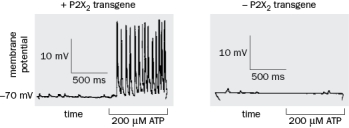In the experiment in Figure , the motor neuron of a muscle expressed the P2X2 transgene and the response in the muscle was recorded. Why did application of ATP activate the muscle?  Figure
Figure
A) Addition of ATP activated of the P2X2 channel which directly increased transmitter release by moving vesicles to the presynaptic membrane.
B) Addition of ATP resulted in opening of the P2X2 channel and an influx of sodium, which activated the motor neuron, releasing neurotransmitter and activation of the muscle.
C) Addition of the resulted in activation of the P2X2 protein, a G protein coupled receptor. Once activated the receptor increased the probability of neurotransmitter release and activated the muscle.
D) Addition of ATP resulted in activation of the ATP receptor, a G protein coupled receptor. Once activated, this G protein indirectly activated P2X2, which increased the probability of neurotransmitter release from the motor neuron and activated the muscle.
Correct Answer:
Verified
Q21: Which of the following are ways to
Q22: What are the advantages and disadvantages of
Q23: What is the advantage of an extracellular
Q24: Why is functional magnetic resonance imaging advantageous
Q25: Carl von Frisch studied honeybee foraging to
Q27: Deep brain stimulation is a technique used
Q28: How does halorhodopsin (NpHR) inactivate neurons?
A) Halorhodopsin
Q29: What is a connectome?
A) A wiring diagram
Q30: How does ChR2 activate neurons?
A) Blue light
Q31: Neurons in the motor cortex are broadly
Unlock this Answer For Free Now!
View this answer and more for free by performing one of the following actions

Scan the QR code to install the App and get 2 free unlocks

Unlock quizzes for free by uploading documents